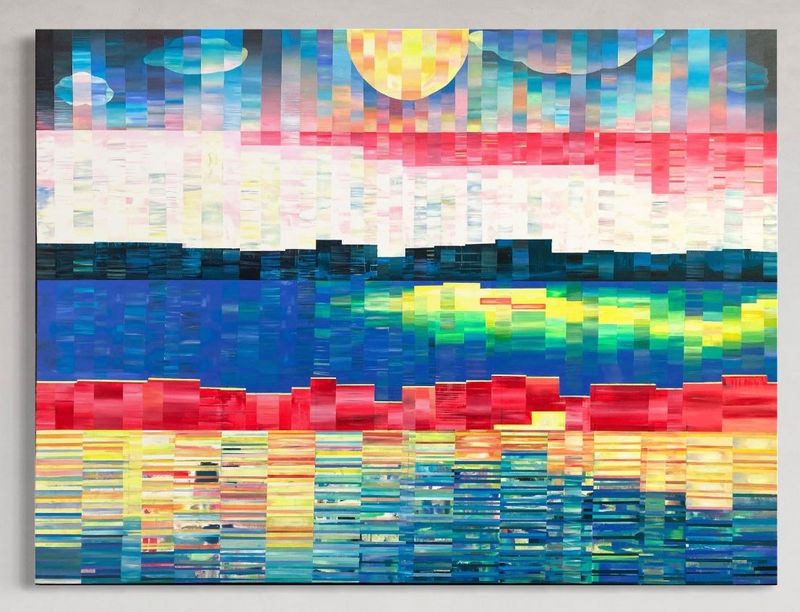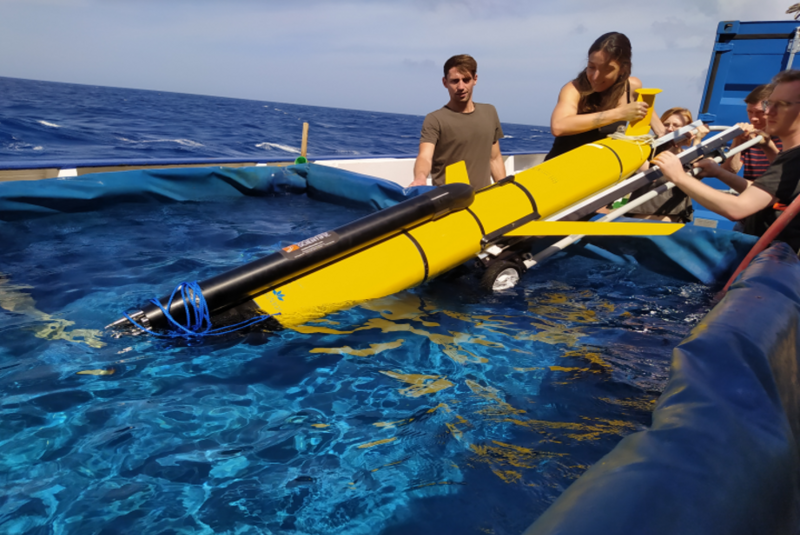Art&Science Collaboration: Paintings created on the basis of TRR181-data
Inspired by graphics and data from the TRR181, Marina Friedrich created two beautiful paintings that now decorate the premises at the CEN in Hamburg.

If one doesn't have a science background, the contents of TRR181 research can sometimes be a little hard to grasp. All those complicated numbers, formulas - and graphs! The latter however, seem to have a fascinating attraction even if we stop focussing on its actual content for a moment. All the coloured curves, lines, gradations and shapes, apart from their enormous scientific significance, somehow have a radiance all of their own. With this in mind, as so often in our "Art&Science" project, we have set out in search of artists who feel this fascination as much as we do – and who also have the wonderful ability to give it a visible expression. The result can now be admired in the form of two paintings by Marina Friedrichs, a young artist and illustrator from Hamburg.
“Layers of Atmosphere and Ocean” acrylic on canvas 155 x 115 cm

The first painting “Layers of Atmosphere and Ocean” represents research on ocean surface layer energetics, focusing on the intricate dynamics occurring within a thin layer near the ocean's surface. The layer, approximately 100 meters thick, serves as a vital interface between the atmosphere and the ocean, facilitating crucial exchanges of heat and momentum. Turbulence plays a significant role in this layer, primarily driven by the interaction between atmospheric forces and ocean currents, which vary with the diurnal cycle and wind patterns.

The diurnal cycle of heating and cooling is a notable phenomenon within this layer. During the day, as the sun warms the atmosphere and ocean, a thin layer of surface waters becomes heated, causing stratification and reducing turbulence. Conversely, during the night and after sunrise, cooling occurs, leading to the destruction of stratification and increased turbulence. This cyclical process is evident in measurements of energy dissipation, with higher dissipation rates observed during cooling periods.

Researchers employ gliders, specialized underwater vehicles, to collect data in this dynamic environment. These gliders are equipped with sensors capable of measuring temperature, pressure, salinity, and turbulence. They navigate the water column in a sawtooth pattern, diving and climbing to depths of up to 100 meters and communicate data back to researchers via satellite. Additionally, the spatial context of the research should be highlighted, focussing on mesoscale eddies – large, rotating vortices that play a significant role in ocean circulation. These eddies demonstrate the complex and energetic nature of ocean currents on a larger scale.
Overall, this research sheds light on the intricate processes occurring within the ocean surface layer, contributing to a deeper understanding of its role in global climate systems and ecosystem dynamics and it is stunning to see how all these aspects are reflected colourfully in the painting.
“Synthesis” acrylic on canvas 155 x 115 cm

The second painting is a collection or collage of all the individual subprojects and therefore represents the entire TRR 181 project.
There are 20 different graphics or parts of them, which grow together to form one large picture. In order to create a uniform image, the colors were reduced to a few shades of blue, violet and coral during the work process. There are painted elements between the graphics, which ensure that the different parts merge into one and create a harmonious image.

This collaboration was another great experience of how to communicate and present the science of TRR181 in an innovative and artistic way. With the beginning of phase 2 of TRR 181, project coordinator Jennifer Fandrich got the funding for the project to start the "Art&Science" collaboration. Since 2020 the CRC has an own outreach subproject, where coordinator Jennifer connects artists with TRR scientists and artistic outputs with scientific input are started. Other significant outputs are from the performative art sector - e.g. a symphony and a theatre play.
From now on, the paintings will be a colourful accompaniment to the project's events and and can be admired in the meantime decorating the premises of our research facility in Hamburg.
Text: Colja Vorhoff
To learn more about Marina Friedrich and her work, please visit her website: www.marinafriedrich.com .